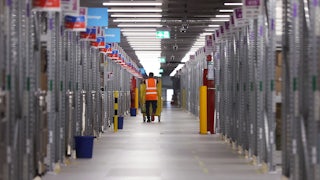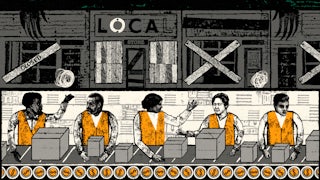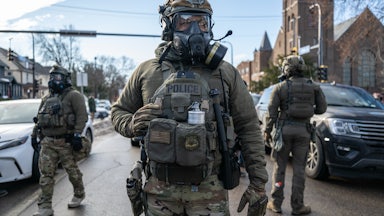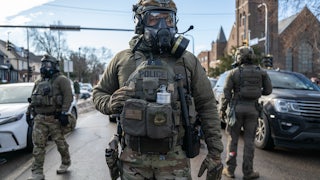This week, about 40 miles from the Amazon warehouse obliterated by a tornado, a worker at one of the company’s fulfillment centers was approached by an Amazon “learning ambassador” and handed a sheet of paper on which a handful of evacuation procedures were written: Walk, don’t run, in case of emergency; follow the manager’s instructions; do not leave the property if you need to escape. The paper listed severe weather rallying points, though no one pointed the actual locations out. It took about a minute for the ambassador to scan the worker’s badge to confirm he’d received the missive. Then it was time to go back to work.
The worker told me he assumed the exercise was designed to check off some box in response to the deaths of six people when a warehouse collapsed in Edwardsville, Illinois. “They should have taken the time for a manager to show the employees where to go for tornado drills, at the least,” he said. He wasn’t scheduled the night of the storms but tracked the severe weather alerts and then the news cycle responding to the deaths. In another facility, in Ohio, an Amazon worker described tornado warnings that pinged warehouse employees’ phones in late October. It took about 10 minutes for managers to let staff stop work and shelter—conveniently, that also marked the end of their shift. “I’ve spent almost a year at Amazon and have yet to do a safety drill of any kind,” he said, though Amazon has vehemently disputed scores of similar claims reported elsewhere.
The six deaths on Friday were reportedly preceded by a refusal to let workers go home, and the incident follows a series of dangerous weather conditions over the last year during which fulfillment center employees were still called in to work. When Hurricane Ida turned New York into a series of rivers, some warehouses kept rolling out packages; during heat waves in the Pacific Northwest this summer, workers were given popsicles and frozen scarves to help them stay productive in 90- and 100-degree temperatures. Since the tornado hit Edwardsville, employees have spoken out about driving through terrible snowstorms and recounted being told that leaving early during a hurricane would adversely affect job reviews.
In response to last week’s tragedy, Amazon has said that it is donating $1 million to a local community foundation, which is likely a fraction of the taxes it isn’t paying the city—when the deal to bring two fulfillment centers to the municipality was made, Edwardsville agreed to waive property taxes for seven years. It’s the kind of selective charity that’s become familiar as severe weather events bring bad press for a company uninterested in interrupting its churn: an Amazon cooling station at the company’s Seattle headquarters, for instance, following reports that warehouse workers were asked to take part in “productivity contests” in 100-degree heat. Or a prompt for customers to say, “Alexa, I want to donate to Hurricane Ida relief.”
A number of Amazon’s policies are under scrutiny since those workers in Edwardsville died—like the reintroduction, in some facilities, of a no-phone policy on warehouse floors, which makes communicating during a disaster (or even knowing about it) impossible, or the obvious lack of cohesive emergency drill policies.
But there’s the more fundamental fact that the company has built a workforce of contract and short-term laborers operating in massive buildings vulnerable to disaster, more of which are appearing as a post-Covid business boom turns into the regular reality of an endless pandemic. Warehouses like the ones in which Amazon employees dodge robots have been more common than commercial buildings since 2018, and they may be more susceptible to being dismantled by a natural disaster: As one engineer told The Verge, “the biggest challenge” for the company may be “their buildings themselves.” This observation was made grimly clear when Edwardsville’s police chief announced that the city didn’t expect to find any survivors: “These walls are made out of 11-inch-thick concrete, and they’re about 40 feet tall,” he said, “so a lot of weight from that came down.” And the company has added a great many of those warehouses to the American landscape over the last few years, reimagining entire neighborhoods at a clip much faster than companies like Walmart or Costco ever did. A recent investigation by Consumer Reports and The Guardian found that 300 new Amazon facilities opened in 2020, a massive number compared to the 75 that opened in prior years.
It’s a problem that Amazon employees say they aren’t being trained to prepare for natural disasters, but how effective could such trainings even be when turnover is so high? Amazon has based its business model on churning through an endlessly replaceable labor force, by some counts replacing 150 percent of its workforce every year. In the weeks leading up to Christmas, the company dramatically expands the number of contractors it uses. Horrifically, Edwardsville police said there were “challenges” to determining how many people worked at the destroyed facility because of how few of them were full-time staff. Later, The New York Times reported that only seven out of the almost 200 people who worked in the delivery center were classified as Amazon employees, significantly reducing the efficacy of intermittent training documents or drill schedules. The numbers of the kind of delivery facility that was destroyed—a smaller warehouse for local drivers—have exploded over the last few years. There were 70 in 2017. Now there are almost 600 spread across the United States, where 3,000 different companies provide 250,000 drivers who are not technically Amazon employees at all. No wonder it’s so hard to find a worker who remembers a tornado drill.
The Edwardsville incident may end up contributing to Amazon’s unbelievable worker turnover, raising the very real possibility—shared by the company’s executives—that it may eventually run out of able-bodied people to employ. “They just run everyone ragged,” said the warehouse worker who was given a piece of paper reminding him that in the event of a disaster, he should stay calm. “I’m actually in the process of trying to find a new job. I don’t trust Amazon to be looking out for us.”








